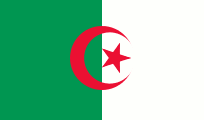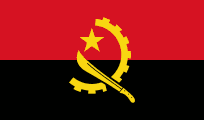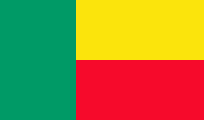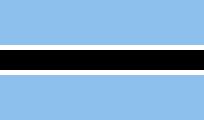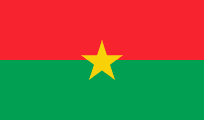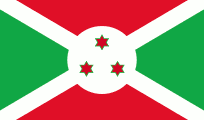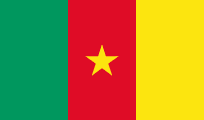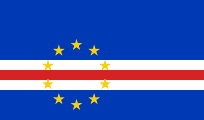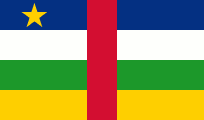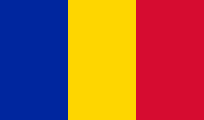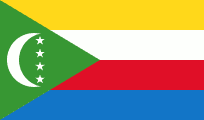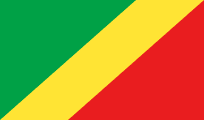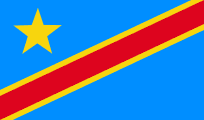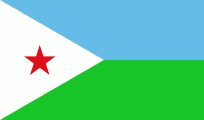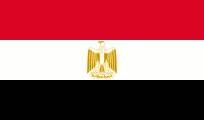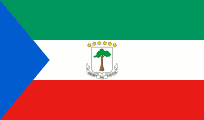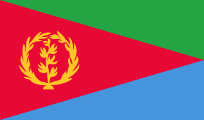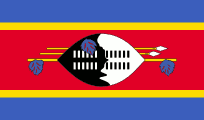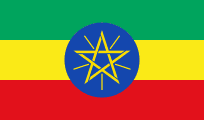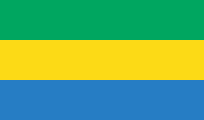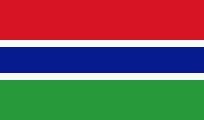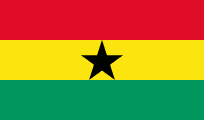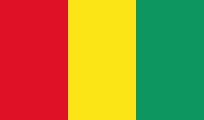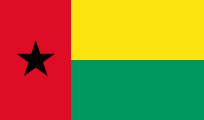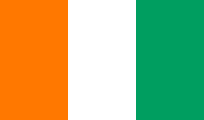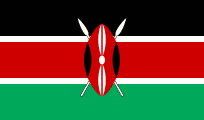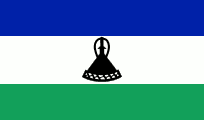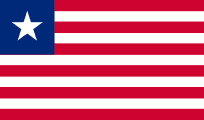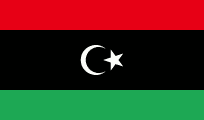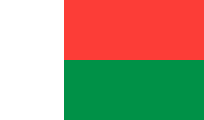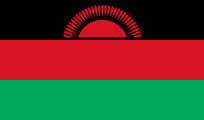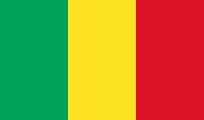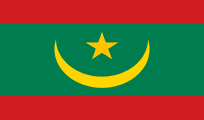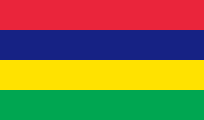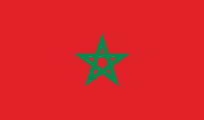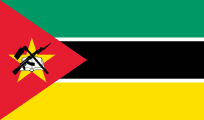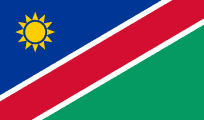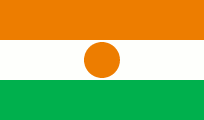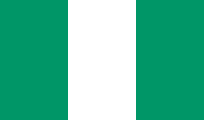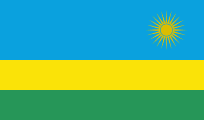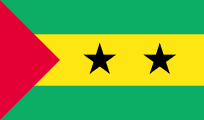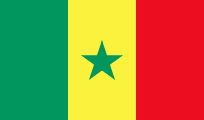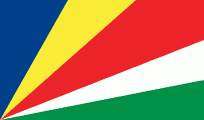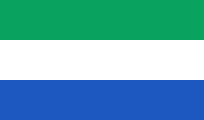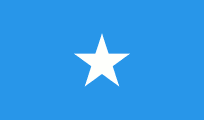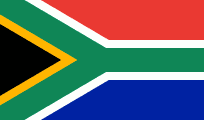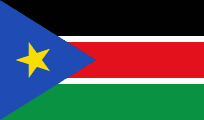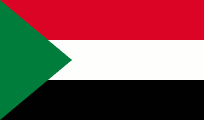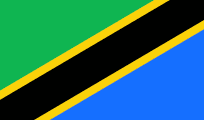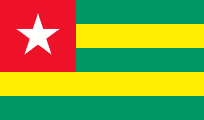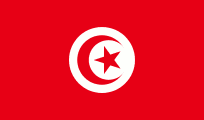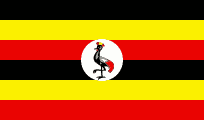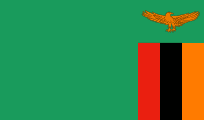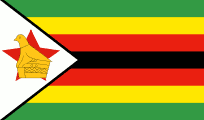Difference between revisions of "Civilisation/World Geography - Africa"
(Added flags and information tables) |
(Added flags and information tables) |
||
| Line 543: | Line 543: | ||
== Gabon == | == Gabon == | ||
[[File:Flag-of-Gabon.png|none|thumb]] | [[File:Flag-of-Gabon.png|none|thumb]] | ||
| + | {| class="wikitable" | ||
| + | |Capital | ||
| + | |Libreville | ||
| + | |- | ||
| + | |Largest cities | ||
| + | |Libreville | ||
| + | |- | ||
| + | |Currency | ||
| + | |CFA franc | ||
| + | |- | ||
| + | |Highest point | ||
| + | |Mont Bengoue | ||
| + | |} | ||
Gabon's name originates from Gabão, Portuguese for "cloak", which is roughly the shape of the estuary of the Komo River by Libreville | Gabon's name originates from Gabão, Portuguese for "cloak", which is roughly the shape of the estuary of the Komo River by Libreville | ||
Gabon lies on the equator | Gabon lies on the equator | ||
| − | Libreville | + | Libreville was founded by freed slaves in 1846. French for “Freetown” |
Gabon's economy is dominated by oil, but it also exports manganese ore | Gabon's economy is dominated by oil, but it also exports manganese ore | ||
| Line 555: | Line 568: | ||
== Gambia == | == Gambia == | ||
[[File:Flag-of-Gambia.png|none|thumb]] | [[File:Flag-of-Gambia.png|none|thumb]] | ||
| + | {| class="wikitable" | ||
| + | |Capital | ||
| + | |Banjul | ||
| + | |- | ||
| + | |Largest cities | ||
| + | |Serekunda | ||
| + | |- | ||
| + | |Currency | ||
| + | |Dalasi | ||
| + | |- | ||
| + | |Highest point | ||
| + | |Unnamed | ||
| + | |} | ||
| + | The Gambia (officially the Republic of the Gambia and often called simply Gambia) is surrounded by Senegal, apart from a short strip of Atlantic coastline at its western end. It is the smallest country on mainland Africa | ||
| + | |||
| + | Banjul is on St Mary's Island, where the Gambia River enters the Atlantic Ocean | ||
| + | |||
Gambia is surrounded by Senegal, apart from a short strip of Atlantic coastline at its western end. It is the smallest country on mainland Africa | Gambia is surrounded by Senegal, apart from a short strip of Atlantic coastline at its western end. It is the smallest country on mainland Africa | ||
| Line 563: | Line 593: | ||
== Ghana == | == Ghana == | ||
[[File:Flag-of-Ghana.png|none|thumb]] | [[File:Flag-of-Ghana.png|none|thumb]] | ||
| − | Ghana was formerly known as Gold Coast. Declared independence from the UK in 1957. Became a republic in 1960 | + | {| class="wikitable" |
| + | |Capital | ||
| + | |Accra | ||
| + | |- | ||
| + | |Largest cities | ||
| + | |Accra, Kumasi | ||
| + | |- | ||
| + | |Currency | ||
| + | |Cedi | ||
| + | |- | ||
| + | |Highest point | ||
| + | |Mount Afadja | ||
| + | |} | ||
| + | Ghana was formerly known as the Gold Coast. Declared independence from the UK in 1957. Became a republic in 1960 | ||
Ghana means “warrior king” | Ghana means “warrior king” | ||
| Line 575: | Line 618: | ||
Lake Volta is the largest reservoir by surface area in the world | Lake Volta is the largest reservoir by surface area in the world | ||
| − | Elmina Castle was erected by | + | Elmina Castle was erected by the Portuguese in 1482. It was the first trading post built on the Gulf of Guinea. First established as a trade settlement, the castle later became one of the most important stops on the route of the Atlantic Slave Trade |
Cape Coast Castle was a slave trade post in Ghana | Cape Coast Castle was a slave trade post in Ghana | ||
Ghana is the closest country to (0°, 0°) | Ghana is the closest country to (0°, 0°) | ||
| + | |||
| + | Akosombo Dam is a hydroelectric dam on the Volta River in southeastern Ghana. The construction of the dam flooded part of the Volta River Basin, and led to the subsequent creation of Lake Volta. Lake Volta is the largest man-made lake in the world by surface area | ||
== Guinea == | == Guinea == | ||
[[File:Flag-of-Guinea.png|none|thumb]] | [[File:Flag-of-Guinea.png|none|thumb]] | ||
| + | {| class="wikitable" | ||
| + | |Capital | ||
| + | |Conakry | ||
| + | |- | ||
| + | |Largest cities | ||
| + | |Conakry | ||
| + | |- | ||
| + | |Currency | ||
| + | |Franc | ||
| + | |- | ||
| + | |Highest point | ||
| + | |Mount Richard-Molard | ||
| + | |} | ||
Guinea is roughly the size of the United Kingdom | Guinea is roughly the size of the United Kingdom | ||
| Line 589: | Line 647: | ||
Fouta Djallon is a highland region in the centre of Guinea | Fouta Djallon is a highland region in the centre of Guinea | ||
| − | + | Conakry is a port city on the Atlantic Ocean and serves as the economic, financial and cultural centre of Guinea. Originally situated on Tombo Island, one of the Îles de Los, it has since spread up the neighbouring Kaloum Peninsula | |
== Guinea-Bissau == | == Guinea-Bissau == | ||
[[File:Flag-of-Guinea-Bissau.png|none|thumb]] | [[File:Flag-of-Guinea-Bissau.png|none|thumb]] | ||
| + | {| class="wikitable" | ||
| + | |Capital | ||
| + | |Bissau | ||
| + | |- | ||
| + | |Largest cities | ||
| + | |Bissau | ||
| + | |- | ||
| + | |Currency | ||
| + | |CFA franc | ||
| + | |- | ||
| + | |Highest point | ||
| + | |Unnamed | ||
| + | |} | ||
Guinea-Bissau is bordered by Senegal to the north and Guinea to the south and east, with the Atlantic Ocean to its west | Guinea-Bissau is bordered by Senegal to the north and Guinea to the south and east, with the Atlantic Ocean to its west | ||
| − | Bissau is located on the Geba River estuary, off the Atlantic Ocean | + | Bissau is located on the Geba River estuary, off the Atlantic Ocean |
Portuguese is the official language of Guinea-Bissau | Portuguese is the official language of Guinea-Bissau | ||
Revision as of 13:47, 26 June 2021
Algeria
| Capital | Algiers |
| Largest cities | Algiers, Oran |
| Currency | Dinar |
| Highest point | Mount Tahat |
Algeria is the largest country in Africa, following the creation of South Sudan
Algiers is only the second capital city in Africa (after Cairo) to have a metro system
The Casbah is specifically the citadel of Algiers and the traditional quarter clustered around it
Tindouf is an Algerian settlement of people exiled from Western Sahara
Hoggar Mountains, also known as the Ahaggar, are a highland region in the central Sahara, southern Algeria
Angola
The emblem of the flag of Angola features a cog wheel and a machete
| Capital | Luanda |
| Largest cities | Luanda, Huambo |
| Currency | Kwanza |
| Highest point | Mount Moco |
Cabinda is an exclave, separated from the rest of Angola by a narrow strip of territory belonging to the Democratic Republic of the Congo, which bounds the province on the south and the east. Cabinda is bounded on the north by the Republic of the Congo, and on the west by the Atlantic Ocean
Diamonds and oil make up 60 percent of Angola's economy, almost all of the country's revenue and are its dominant exports
Portuguese is the official language of Angola
Luanda is one of the world's most expensive cities for resident foreigners. Third most-populous Portuguese-speaking city, behind Sao Paulo and Rio de Janeiro
Benin
| Capital | Porto-Novo |
| Largest cities | Cotonou |
| Currency | CFA franc |
| Highest point | Mont Sokbaro |
In 1960, Dahomey gained full independence from France. A Marxist-Leninist state called the People's Republic of Benin existed between 1975 and 1990. In 1991, it was replaced by the current multi-party Republic of Benin
The capital of Benin is Porto-Novo, but the seat of government is in Cotonou, the country's largest city and economic capital
Botswana
| Capital | Gaborone |
| Largest cities | Gaborone |
| Currency | Pula |
| Highest point | Otse Hill |
Formerly the British protectorate of Bechuanaland, Botswana adopted its new name after becoming independent within the Commonwealth in 1966
Kalahari Desert covers 70% of Botswana
Okavango Delta is a large inland delta formed where the Okavango River reaches a tectonic trough in the central part of the endorheic basin of the Kalahari
Makgadikgadi Pan is a large salt pan in Northern Botswana, the largest salt flat complex in the world
Debswana, the largest diamond mining company operating in Botswana, is 50% owned by the government and 50% owned by De Beers. The mineral industry provides about 40% of all government revenues
Burkina Faso
| Capital | Ouagadougou |
| Largest cities | Ouagadougou |
| Currency | CFA franc |
| Highest point | Mount Tenakourou |
Formerly called the Republic of Upper Volta, the country was renamed Burkina Faso in 1984 after a coup d’état led by Thomas Sankara
Burkina Faso means “land of the upright/honest people”
The country owes its former name of Upper Volta to three rivers which cross it: the Black Volta, the White Volta and the Red Volta
Burundi
| Capital | Gitega (see note below) |
| Largest cities | Bujumbura, Gitega |
| Currency | Franc |
| Highest point | Mount Heha |
Note: Gitega replaced Bujumbura is the capital in 2019. Bujumbura remains as the economic capital
At the beginning of the twentieth century, Germany colonized the region. After the First World War and its defeat, it ceded the territory to Belgium
Although the country is landlocked, much of the southwestern border is adjacent to Lake Tanganyika
The Twa, Hutu and Tutsi peoples have lived in Burundi for at least 500 years
Cameroon
| Capital | Yaounde |
| Largest cities | Douala, Yaounde |
| Currency | CFA franc |
| Highest point | Mount Cameroon |
After World War I, the territory was divided between France and Britain as League of Nations mandates
The country was renamed the Republic of Cameroon in 1984
Cameroon's coastline lies on the Bight of Bonny, part of the Gulf of Guinea and the Atlantic Ocean
Cameroon is described as "Africa in miniature" because it exhibits all major climates and vegetation of the continent
Lake Nyos is a crater lake in Cameroon. A pocket of magma lies beneath the lake and leaks carbon dioxide into the waters. In 1986 the lake suddenly emitted a large cloud of CO2, which suffocated 1,700 people and 3,500 livestock in nearby villages
Cape Verde (Cabo Verde)
The 10 stars on the flag of Cape Verde represent the main islands
| Capital | Praia |
| Largest cities | Praia, Mindelo |
| Currency | Escudo |
| Highest point | Mount Fogo |
Cape Verde is an archipelago of ten volcanic islands, split into the Barlavento Islands and the Sotavento Islands. The largest island, both in size and population, is Santiago, which hosts the nation's capital, Praia
The islands are located 570 km off the coast of Western Africa
Cape Verde gained independence from Portugal in 1975
Central African Republic
| Capital | Bangui |
| Largest cities | Bangui, Bimbo |
| Currency | CFA franc |
| Highest point | Mont Ngaoui |
Central African Republic gained independence from France in 1960
Known as Central African Empire under Bokassa between 1976 and 1979
Much of the country consists of flat or rolling plateau savanna
Two thirds of the country is within the Ubangi River basin, which flows into the Congo
Chad
Flag of Chad is almost identical to the flag of Romania
| Capital | N'Djamena |
| Largest cities | N'Djamena |
| Currency | CFA franc |
| Highest point | Emi Koussi |
Because of this distance from the sea and the country's largely desert climate, Chad is sometimes referred to as the "Dead Heart of Africa"
The country is named after Lake Chad
N'Djamena was founded as Fort-Lamy by French commander Emile Gentil in1900. Changed its name in 1973
Arabic and French are the official languages of Chad
Emi Koussi is a volcano which is the highest mountain in the Sahara
Comoros
The four stripes on the flag of Comoros represent the four islands
| Capital | Moroni |
| Largest cities | Moroni |
| Currency | Franc |
| Highest point | Mount Karthala |
Comoros is located at the northern end of the Mozambique Channel off the eastern coast of Africa between northeastern Mozambique and northwestern Madagascar
Comoros is formed by Ngazidja (Grande Comore), Mwali (Moheli), Nzwani (Anjouan), and Mahore (Mayotte), the major islands in the Comoros Archipelago, as well as many minor islets
Moheli seceded from the Comoros in 1997, but rejoined in 1998
Moroni is on the island of Grande Comore
Sunni Islam is the dominant religion in Comoros
Congo Republic (Republic of the Congo, or Congo)
| Capital | Brazzaville |
| Largest cities | Brazzaville, Pointe-Noire |
| Currency | CFA franc |
| Highest point | Mont Nabemba |
Congo Republic was known as French Congo until independence in 1960
Brazzaville was founded in 1880 by an Italo-French explorer, Pierre Savorgnan de Brazza. It is located on the Congo River
Pointe-Noire is the main commercial centre of the country
Democratic Republic of the Congo (DR Congo)
| Capital | Kinshasa |
| Largest cities | Kinshasa, Lubumbashi |
| Currency | Franc |
| Highest point | Mount Stanley |
DR Congo is the second largest country in Africa by area and the eleventh largest in the world. It is the most populous officially Francophone country, and the fourth most populous nation in Africa
Known as Zaire from 1971 to 1997
Kinshasa was known as Leopoldville, in honour of King Leopold II of Belgium. Second largest francophone urban area in the world after Paris. Kinshasa was founded as a trading post by Henry Morton Stanley in 1881
Lubumbashi is the mining capital of DR Congo, acting as a hub for many of the country's biggest mining companies. The copper-mining city serves as the capital of the Katanga Province
Kisangani was known as Stanleyville. It is the third largest urbanized city in the country
Ituri forest is in DR Congo
Moanda or Muanda is a town at the mouth of the Congo River. Some 100 km upstream from Muanda, lies the city of Boma, DR Congo's second-largest port. The great width and depth of the Congo River allow seagoing vessels to reach Boma and the largest port, Matadi, despite their distance from the coast
East and West Kasai are provinces in DR Congo
Mount Nyiragongo is a stratovolcano in the Virunga Mountains associated with the Albertine Rift. The main crater is about two km wide and usually contains a lava lake
Nyamuragira is an active volcano in the Virunga Mountains. It has been described as Africa's most active volcano and has erupted over 40 times since 1885
DR Congo's largest export is raw minerals, with China accepting over 50% of exports in 2012
Djibouti
| Capital | Djibouti |
| Largest cities | Djibouti |
| Currency | Franc |
| Highest point | Mousa Aki |
French Territory of Afars and Issas was the name given to present-day Djibouti between 1967 and 1977, while it was still a colony of France. The area was formerly known as French Somaliland
The Somali and Afar make up the two largest ethnic groups
The country is named for its capital, the City of Djibouti
Lake Assal is a crater lake in central Djibouti. It lies 155m below sea level in the Afar Depression and its shores comprise the lowest point on land in Africa and the second lowest land depression on Earth after the Dead Sea. Lake Assal is considered the most saline body of water on earth outside Antarctica, with 34.8% salt concentration
Egypt
Flag of Egypt contains the Eagle of Saladin
| Capital | Cairo |
| Largest cities | Cairo, Alexandria, Giza |
| Currency | Pound |
| Highest point | Mount Catherine |
Egypt is the most populous country in North Africa and the Arab World, and the third most populous in Africa
Cairo is the largest city in the Middle East and second-largest in Africa after Lagos. Its metropolitan area is the 13th largest in the world
Cairo was the first African city to have an underground railway
Alexandria is the largest African city on the Mediterranean and a major economic centre in Egypt
Sharm el-Sheikh is situated on the southern tip of the Sinai Peninsula, on the coastal strip along the Red Sea. It is a major tourist location
Suez Canal was built by Ferdinand De Lesseps. Opened in 1869. Suez Canal has no locks
Port Said is at the northern end of Suez Canal
Bitter lakes are in the Suez Canal
Suez Canal Bridge was built with assistance from the Japanese government
When Lake Nasser was being created as a result of the construction of the Aswan High Dam, across the Nile, between 1958 and 1970, the anticipated rising waters behind the dam required major relocation projects. Several important Nubian and Ancient Egyptian archaeological sites were dismantled block by block and moved to higher ground, most notably Abu Simbel
Memphis was the first capital of Egypt
Saqqura is a vast, ancient burial ground, serving as the necropolis for Memphis. Saqqara features numerous pyramids, including the Step pyramid of Djoser
The Pyramids of Giza consist of the Great Pyramid of Giza (known as the Pyramid of Cheops or Khufu), the somewhat smaller Pyramid of Khafre (or Chephren) a few hundred meters to the south-west, and the relatively modest-sized Pyramid of Menkaure (or Mykerinos) a few hundred meters further south-west. The Great Sphinx lies on the east side of the complex. Current consensus among Egyptologists is that the head of the Great Sphinx is that of Khafre
The Great Pyramid of Giza is 483 feet high and houses seventy-ton pieces of granite lifted to a level of 175 feet
It is thought that, at construction, the Great Pyramid was originally 280 Egyptian cubits tall. Each base side was 440 cubits long
The Great Pyramid of Giza remained the tallest man-made structure in the world for over 3,800 years, unsurpassed until the 160m tall spire of Lincoln Cathedral was completed c. 1300
As the site of the Ancient Egyptian city of Thebes, Luxor has frequently been characterized as the ‘world's greatest open air museum’, as the ruins of the temple complexes at Karnak and Luxor stand within the modern city
Luxor Temple was dedicated to the Theban Triad of Amun, Mut, and Chons and was built during the New Kingdom
Precinct of Amun-Re, located near Luxor, is one of the four main temple enclosures that make up the immense Karnak Temple Complex. The precinct is by far the largest of these and the only one that is open to the general public. The temple complex is dedicated to the principal god of the Theban Triad, Amun, in the form of Amun-Re
Lighthouse of Alexandria, also known as the Pharos of Alexandria, was a tower built between 280 and 247 BC on the island of Pharos at Alexandria. Its purpose was to guide sailors into the harbour at night time. With a height variously estimated at somewhere in-between 393 and 450 ft (120 and 140 m), it was for many centuries among the tallest manmade structures on Earth
Library of Alexandria was the largest and most significant great library of the ancient world. It flourished under the patronage of the Ptolemaic dynasty and functioned as a major centre of scholarship from its construction in the 3rd century BC until the Roman conquest of Egypt in 30 BC
The best known artifact in King Tutankhamun’s tomb is the famous Gold Mask, on display at the Museum of Egyptian Antiquities in Cairo
Temple of Edfu is located on the west bank of the Nile in the city of Edfu which was known in Greco-Roman times as Apollonopolis Magna, after the chief god Horus-Apollo. It is one of the best preserved temples in Egypt. The temple, dedicated to the falcon god Horus, was built in the Ptolemaic period between 237 and 57 BC
North of Cairo, the Nile splits into two branches (or distributaries) that feed the Mediterranean: the Rosetta Branch to the west and the Damietta to the east, forming the Nile Delta
Mount Sinai is a mountain in the Sinai Peninsula. Means “Mount Moses”
Qattara Depression contains the second lowest point in Africa at 133m below sea level, the lowest being Lake Assal in Djibouti
Nile Delta is sometimes divided into sections, with the Nile dividing into two main distributaries, the Damietta and the Rosetta, flowing into the Mediterranean at port cities with the same name
Equatorial Guinea
Coat of arms on the flag of Equatorial Guinea contains a silk cotton tree
| Capital | Malabo (see note below) |
| Largest cities | Bata, Malabo |
| Currency | CFA franc |
| Highest point | Pico Basile |
Note: Ciudad de la Paz, formerly Oyala, is being built to replace Malabo as the national capital
Equatorial Guinea consists of two parts, an insular and a mainland region. The insular region consists of the islands of Bioko (formerly Fernando Po) in the Gulf of Guinea and Annobon. Sao Tome and Principe is located between Bioko and Annobon. The mainland region, Rio Muni, is bordered by Cameroon on the north and Gabon on the south and east. It is the location of Bata, Equatorial Guinea's largest city, and Ciudad de la Paz
Malabo is located on the northern coast of Bioko Island on the rim of a sunken volcano
Black Beach, located in Malabo, is of one of Africa's most notorious prisons
Formerly the colony of Spanish Guinea, Equatorial Guinea is the only country in mainland Africa whose de jure official language is Spanish
Since the mid-1990s, Equatorial Guinea has become one of sub-Sahara's largest oil producers
Eritrea
Flag of Eritrea contains an emblem of a wreath with an upright olive-branch
| Capital | Asmara |
| Largest cities | Asmara |
| Currency | Nakfa |
| Highest point | Emba Soira |
In 1936, Eritrea became a province of Italian East Africa, along with Ethiopia and Italian Somaliland. Eritrea declared its independence from Ethiopia and gained international recognition in 1993
Asmara is known for its well-preserved colonial Italian modernist architecture
Tigrinya people make up about 55% and Tigre people make up about 30% of the population
Eswatini (Swaziland)
The flag of Eswatini was adopted in 1968, following the independence of Swaziland. It features a black and white shield, with a staff and two spears
| Capital | Mbabane |
| Largest cities | Manzini, Mbabane |
| Currency | Lilangeni |
| Highest point | Emlembe |
In 2018, King Mswati III announced that the Kingdom of Swaziland had renamed itself the Kingdom of Eswatini
Eswatini is bordered by South Africa and Mozambique
The country and its people take their names from King Mswati II
Eswatini has been ruled by King Mswati III since 1986
Lobamba is the royal and legislative capital
The topography of Eswatini is diverse, ranging from a cool and mountainous highveld to a hot and dry lowveld
Eswatini is the smallest landlocked country in the Southern Hemisphere
Ethiopia
Flag of Ethiopia contains an emblem with a golden pentagram
| Capital | Addis Ababa |
| Largest cities | Addis Ababa |
| Currency | Birr |
| Highest point | Ras Dejen |
Ethiopia is the most populous landlocked country in the world, as well as the second-most populated nation on the African continent
Ethiopia has been landlocked since 1993
Ethiopia was the only African country to defeat a European colonial power and retain its sovereignty as an independent country
The largest ethnic groups are the Oromo and the Amhara
Addis Ababa is the headquarters of the African Union
The fossilized skeleton, and a plaster replica of the early hominid Lucy (known in Ethiopia as Dinkinesh), is preserved at the Ethiopian National Museum in Addis Ababa
The rock-hewn churches of Lalibela are a World Heritage site
Axum was the original capital of the eponymous kingdom of Axum. The major Aksumite monuments in the town are stelae
Debre Damo is the name of a flat-topped mountain, or amba, and a 6th century monastery in northern Ethiopia. The monastery, accessible only by rope up a sheer cliff, is known for its collection of manuscripts
Erta Ale is a continuously active basaltic shield volcano in the Afar Region of northeastern Ethiopia, the most active volcano in Ethiopia. It has one or sometimes two active lava lakes at the summit
Tigray is the northernmost region of Ethiopia
Ogaden is a territory comprising the southeastern portion of the Somali Regional State in Ethiopia
Grand Ethiopian Renaissance Dam, sometimes referred to as Hidase Dam, is an under-construction gravity dam on the Blue Nile River in Ethiopia
Dallol, in the Danakil Desert, holds the official record for record high average temperature for an inhabited location on Earth
Great Rift Valley of Ethiopia is a branch of the East African Rift
Semien Mountains are part of the Ethiopian Highlands
Gabon
| Capital | Libreville |
| Largest cities | Libreville |
| Currency | CFA franc |
| Highest point | Mont Bengoue |
Gabon's name originates from Gabão, Portuguese for "cloak", which is roughly the shape of the estuary of the Komo River by Libreville
Gabon lies on the equator
Libreville was founded by freed slaves in 1846. French for “Freetown”
Gabon's economy is dominated by oil, but it also exports manganese ore
Almost all Gabonese are of Bantu origin
Gambia
| Capital | Banjul |
| Largest cities | Serekunda |
| Currency | Dalasi |
| Highest point | Unnamed |
The Gambia (officially the Republic of the Gambia and often called simply Gambia) is surrounded by Senegal, apart from a short strip of Atlantic coastline at its western end. It is the smallest country on mainland Africa
Banjul is on St Mary's Island, where the Gambia River enters the Atlantic Ocean
Gambia is surrounded by Senegal, apart from a short strip of Atlantic coastline at its western end. It is the smallest country on mainland Africa
Banjul, the capital of Gambia, is on St Mary's Island, where the Gambia River enters the Atlantic Ocean
Serekunda is the largest urban centre in The Gambia
Ghana
| Capital | Accra |
| Largest cities | Accra, Kumasi |
| Currency | Cedi |
| Highest point | Mount Afadja |
Ghana was formerly known as the Gold Coast. Declared independence from the UK in 1957. Became a republic in 1960
Ghana means “warrior king”
Black Star Square, also known as Independence Square, is a public square in Accra. It is the second-largest city square in the world after Tiananmen Square in China
Kumasi is the capital of Ashanti region of Ghana, and is Ghana’s second largest city
Golden Stool was the royal and divine throne of the Ashanti people
Lake Volta is the largest reservoir by surface area in the world
Elmina Castle was erected by the Portuguese in 1482. It was the first trading post built on the Gulf of Guinea. First established as a trade settlement, the castle later became one of the most important stops on the route of the Atlantic Slave Trade
Cape Coast Castle was a slave trade post in Ghana
Ghana is the closest country to (0°, 0°)
Akosombo Dam is a hydroelectric dam on the Volta River in southeastern Ghana. The construction of the dam flooded part of the Volta River Basin, and led to the subsequent creation of Lake Volta. Lake Volta is the largest man-made lake in the world by surface area
Guinea
| Capital | Conakry |
| Largest cities | Conakry |
| Currency | Franc |
| Highest point | Mount Richard-Molard |
Guinea is roughly the size of the United Kingdom
The sources of the Niger River, Gambia River, and Senegal River are all found in the Guinea Highlands
Fouta Djallon is a highland region in the centre of Guinea
Conakry is a port city on the Atlantic Ocean and serves as the economic, financial and cultural centre of Guinea. Originally situated on Tombo Island, one of the Îles de Los, it has since spread up the neighbouring Kaloum Peninsula
Guinea-Bissau
| Capital | Bissau |
| Largest cities | Bissau |
| Currency | CFA franc |
| Highest point | Unnamed |
Guinea-Bissau is bordered by Senegal to the north and Guinea to the south and east, with the Atlantic Ocean to its west
Bissau is located on the Geba River estuary, off the Atlantic Ocean
Portuguese is the official language of Guinea-Bissau
Ivory Coast (Côte d'Ivoire)
Ivory Coast gained independence from France in 1960
Yamoussoukro is the official political capital and administrative capital city of Côte d'Ivoire
Yamoussoukro is the site of what is claimed to be the largest Christian place of worship on Earth: The Basilica of Our Lady of Peace of Yamoussoukro, consecrated by Pope John Paul II in 1990
Abidjan is the economic capital and largest city of Ivory Coast
St. Paul’s Cathedral in Abidjan is one of the largest cathedrals in the world
Kenya
Nairobi was founded in 1899 by the colonial authorities in British East Africa, as a rail depot on the Uganda Railway
Nairobi is one of the few cities in the world with a national park within its boundaries
Kibera is the largest slum in Nairobi, and one of the largest urban slums in Africa
Karen Blixen museum is near Nairobi
Mombasa is the second-largest city in Kenya
Moi Avenue is a primary thoroughfare in Mombasa, and known for two pairs of giant aluminium elephant tusks crossing the dual carriageway
Mount Kenya is the highest mountain in Kenya and the second-highest in Africa (after Mount Kilimanjaro). The highest peaks of the mountain are Batian, Nelion and Lenana
Aberdare National Park covers the higher areas of the Aberdare Mountain Range of central Kenya
Lesotho
Lesotho is an enclaved landlocked country completely surrounded by South Africa
The present Lesotho, then called Basutoland, emerged as a single polity under King Moshoeshoe I in 1822
Lesotho is the only independent state in the world that lies entirely above 1,000 m in elevation. Its lowest point of 1,400 is thus the highest in the world
Lesotho's population consists almost entirely of the Basotho, a Bantu-speaking people
Maseru is the capital and largest city of Lesotho
Liberia
Liberia is bordered by Sierra Leone to its west, Guinea to its north and Ivory Coast to its east
Liberia was established in 1822 by the American Colonisation Society (ACS) as an American colony to where the ACS could send former slaves
English is the official language of Liberia
Monrovia is the capital and largest city of Liberia
Monrovia is named in honor of U.S. President James Monroe, a prominent supporter of the colonization of Liberia
Due to its status as a flag of convenience, Liberia has the second-largest maritime registry in the world behind Panama
Libya
Libya is the fourth largest country in Africa
Libya's coastline is the longest of any African country bordering the Mediterranean
Libyan Desert, which covers much of Libya, is one of the most arid and sun-baked places on earth
The three traditional parts of the country are Tripolitania, Fezzan and Cyrenaica
The largest city and capital, Tripoli, is located in western Libya and contains over one million of Libya's six million people
Benghazi is the second largest city in Libya
Misrata is the third largest city in Libya
Leptis Magna in Libya achieved its greatest prominence beginning in 193, when a native son, Lucius Septimius Severus, became emperor. The arch of Septimius Severus is one of the main tourist attractions
Gulf of Sidra is a body of water in the Mediterranean Sea on the northern coast of Libya; it is also known as Gulf of Sirte
Madagascar
Madagascar is the fourth largest island in the world
Malagasy Republic was established in 1958 as an autonomous republic within the newly created French Community and existed until the proclamation of the Democratic Republic of Madagascar in 1975
Antananarivo was known as Tananarive during the period of French rule
Toamasina is the chief seaport of Madagascar
Madagascar spiny forests is an ecoregion in Madagascar
Madagascar is a biodiversity hotspot; over 90 percent of its wildlife is found nowhere else on Earth
The Avenue or Alley of the Baobabs is a prominent group of baobab trees lining a dirt road in western Madagascar
Malawi
Nyasaland became independent from British rule and renamed itself Malawi in 1964
Malawi is separated from Tanzania and Mozambique by Lake Malawi
Lilongwe is the capital and largest city of Malawi
Blantyre is the second largest city in Malawi
Zomba was the first capital of Malawi and remained so until 1974
Lake Malawi takes up about a third of Malawi's area. It is sometimes called the Calendar Lake as it is about 365 miles long and 52 miles wide
The Great Rift Valley runs through the country from north to south
Mali
Present-day Mali was once part of three West African empires that controlled trans-Saharan trade: the Ghana Empire, the Mali Empire (for which Mali is named), and the Songhai Empire
Bamako is the capital and largest city in Mali. It is one of the fastest growing cities in Africa. Means “crocodile river”
Bamako is situated on the Niger River floodplain
Timbuktu was established as a trading post for salt. Discovered by Alexander Laing in 1826
Timbuktu is 12 miles north of the River Niger
Djenne in Mali is famous for its distinctive mud-brick (adobe) architecture, most notably the Great Mosque
Mauritania
90% of Mauritania's land is within the Sahara Desert
Mauritania was part of French West Africa from 1920 until independence in 1960
The capital and largest city of Mauritania is Nouakchott, located on the Atlantic coast
Iron ore accounts for 50% of exports from Mauritania
Oil was discovered in Mauritania in 2001
Mauritius
Mauritius is an island nation in the Indian Ocean about 2,000 km off the southeast coast of the African continent. The country includes the island of Mauritius, Rodrigues, the islands of Agalega, and the archipelago of Saint Brandon
Mauritius claims sovereignty over the Chagos Archipelago. The United Kingdom excised the Chagos Archipelago from Mauritian territory prior to Mauritian independence in 1965
The capital and largest city is Port Louis
Blue Penny Museum is a stamp museum in Port Louis
Morocco
Morocco is one of only three countries (with Spain and France) to have both Atlantic and Mediterranean coastlines
Morocco claims the non-self-governing territory of Western Sahara as its Southern Provinces
Morocco includes the Spanish-controlled exclaves of Ceuta and Melilla
Largest cities – Casablanca, Rabat, Fez, Marrakesh, Tangier
Casablanca is Morocco's chief port and industrial centre. Means “white house”
Fes was the capital of Morocco until 1925. The city has two old medinas, the larger of which is Fes el Bali. It is listed as a UNESCO World Heritage Site and is believed to be one of the world's largest car-free urban areas
The Jemaa el-Fnaa in Marrakesh is one of the best-known squares in Africa
Tangier lies on the North African coast at the western entrance to the Strait of Gibraltar
The imperial cities of Morocco are the four historical capital cities of Morocco: Fes, Marrakesh, Meknes and Rabat
A large part of Morocco is mountainous. The Atlas Mountains are located mainly in the centre and the south of the country. The Rif Mountains are located in the north of the country. Both ranges are mainly inhabited by the Berber people
Marrakech Express – rail journey from Casablanca to Marrakech, via Rabat
Mozambique
Mozambique is separated from Madagascar by the Mozambique Channel to the east
The country is divided into two topographical regions by the Zambezi River
The capital and largest city is Maputo (previously called Lourenço Marques before independence)
Mozambique gained independence from Portugal in 1975
The only official language of Mozambique is Portuguese
Nacala is the deepest natural port on the east coast of Africa
Bazaruto Archipelago is a tourist destination in Mozambique
Mount Mabu is a mountain in northern Mozambique, famous for its old-growth rainforest
Namibia
Although Namibia does not border Zimbabwe, less than 200 m of the Zambezi River separates them at their closest points
Namibia gained independence from South Africa in 1990. Formerly known as South West Africa
Windhoek is the capital and largest city of Namibia
Walvis Bay (“Whale Bay”) is a safe haven for sea vessels because of its natural deepwater harbour
Swakopmund is situated in the Namib desert and is the fourth largest population centre in Namibia. Swakopmund is a beach resort and an example of German colonial architecture. It was founded in 1892 as the main harbour for German South-West Africa
Caprivi Strip is a narrow protrusion of Namibia eastwards from the Okavango Region about 450 km, between Botswana to the south, and Angola and Zambia to the north
Penguin Islands are a group of islands and rocks situated along a stretch of 355 km along the coastline of Namibia
Etosha pan is a large endorheic salt pan, forming part of the Kalahari Basin in the north of Namibia. The dry lakebed and its surroundings are protected as Etosha National Park, one of Namibia's largest wildlife parks
There has been significant investment in uranium mining and Namibia is set to become the largest exporter of uranium by 2015. Rich alluvial diamond deposits make Namibia a primary source for gem-quality diamonds
Niger
Niger is named after the Niger River. It the largest nation in West Africa, with over 80 % of its land area covered by the Sahara desert
Niger is the largest landlocked country in Africa
The capital city is Niamey, located in the far-southwest corner of Niger
The Agadez Region represents 52% of the total area of Niger, the largest of its seven regions
Niger is an exporter of uranium ore
Nigeria
Nigeria is the most populous country in Africa and the seventh most populous country in the world
The three largest ethnic groups are the Hausa, Igbo and Yoruba
Nigeria achieved independence from UK in 1960
In 2014, Nigeria's economy (GDP) became the largest in Africa, overtaking South Africa
Niger Delta is the delta of the Niger River at the Gulf of Guinea on the Atlantic Ocean in Nigeria. It is a very densely populated region sometimes called the Oil Rivers because it was once a major producer of palm oil
Nigeria has six cities with a population of over 1 million people (from largest to smallest: Lagos, Kano, Ibadan, Kaduna, Port Harcourt, and Benin City). Lagos is the largest city in sub-Saharan Africa, with a population of over 8 million in its urban area alone
Federal Capital Territory is the home of Abuja, the capital of Nigeria. It officially became Nigeria's capital in 1991, replacing Lagos
Zuma Rock is a large monolith near Abuja
The principal inhabitants of Kano are the Hausa people
At Nigerian independence, Ibadan was the largest and most populous city in the country and the third in Africa after Cairo and Johannesburg
Port Harcourt is the chief oil-refining city in Nigeria
Rwanda
Germany colonised Rwanda in 1884 as part of German East Africa, followed by Belgium, which invaded in 1916 during World War I. Both European nations ruled through the kings and perpetuated a pro-Tutsi policy. The Hutu population revolted in 1959
Rwanda's economy suffered heavily during the 1994 Rwandan Genocide
Rwanda is known as the “country of 1000 hills”
The capital and largest city, Kigali, is located near the centre of Rwanda
Volcanoes National Park was the base for the zoologist Dian Fossey
Mountains of the Moon or Montes Lunae referred to a mountain range in Rwanda that was long believed to be the source of the White Nile, but whose actual location was – and remains – uncertain
Sao Tome and Principe
Sao Tome and Principe consists of two archipelagos around the two main islands: São Tomé and Príncipe, located about 140 km apart, in the Gulf of Guinea off the northwestern coast of Gabon
Sao Tome was named in honour of Saint Thomas by Portuguese explorers who arrived at the island on his feast day
Príncipe (“Prince's island”) was named in honour of Afonso, Prince of Portugal
Sao Tome and Principe is the second-smallest African country, behind Seychelles. It is also the smallest Portuguese-speaking country
Sao Tome is the capital city of Sao Tome and Principe
Senegal
Senegal is named the Senegal River that borders it to the east and north
Cap Vert Peninsula in Senegal is the most westerly point on the African mainland
Pointe des Almadies is the westernmost point on the continent of Africa. Pointe des Almadies is located on the northwestern end of the Cap Vert peninsula
Senegal's capital and largest city is Dakar
Goree Island was a Dakar slave centre
African Renaissance Monument is a 49 m tall bronze statue in Dakar. It is the tallest statue in Africa
Seychelles
Seychelles is an archipelago in the Indian Ocean. Consists of 115 islands, and lies 1,500 km east of mainland Southeast Africa
Seychelles has the smallest population of any African state
Seychelles were known as “The Seven Sisters” by Portuguese explorers
The Seychelles became a crown colony separate from Mauritius in 1903 and independence was granted in 1976, as a republic within the Commonwealth
Victoria is the capital city of the Seychelles and is situated on Mahe island, the archipelago's main island. The city was first established as the seat of the British colonial government
Victoria has a clocktower modelled on that of Vauxhall Clock Tower
Sierra Leone
Sierra Leone is bordered by Guinea in the north-east, Liberia in the south-east, and the Atlantic Ocean in the southwest
Freetown is the capital and largest city. It was christened by former American slaves in 1792
From 1808 to 1874, Freetown served as the capital of British West Africa
Bo is the second largest city in Sierra Leone
Sierra Leone has relied on mining, especially diamonds, for its economic base. It is also among the largest producers of titanium and bauxite, a major producer of gold, and has one of the world's largest deposits of rutile. Sierra Leone is home to the third-largest natural harbour in the world
Somalia
Somalia has the longest coastline on the continent's mainland. It is in the Horn of Africa
British Somaliland and Italian Somaliland united to form the Somali Republic in 1960
Mogadishu is the capital and largest city in Somalia
Puntland is an autonomous region in Somalia. Eyl is a pirate haven in Puntland
Somaliland is a self-declared but unrecognized sovereign state
South Africa
South African capitals – Cape Town (legislative), Pretoria (administrative), Bloemfontein (judicial)
There are nine provinces in South Africa –
Eastern Cape
Capital city – Bhisho
Largest city – Port Elizabeth (Gqeberha)
Mthatha (known as Umtata) – largest city in Transkei, which became part of Eastern Cape Province in 1994
Free State
Capital and largest city – Bloemfontein
Vredefort crater in South Africa is the largest verified impact crater on Earth
Free State was formerly known as Orange Free State
Gauteng
Capital and largest city – Johannesburg
Gauteng was formed from part of the old Transvaal Province after South Africa's elections in 1994
Sophiatown is a suburb of Johannesburg. Originally called Sophiatown, it was destroyed, and a white suburb called Triomf (Triumph) was established in its place by the apartheid government, before the name Sophiatown was officially restored in 2006
Pretoria is in Gauteng province
Pretoria is also known as Tshwane
KwaZulu-Natal
Capital – Pietermaritzburg
Largest city – Durban
Before the end of apartheid in 1994, Pietermaritzburg was the capital of Natal Province
Port Natal was renamed Durban in honor of then Cape Colony Governor, Sir
Benjamin d’Urban
Limpopo
Capital and largest city – Polokwane (Pietersburg)
The province was formed from the northern region of Transvaal Province in 1994, and initially named Northern Transvaal
Mpumalanga
Capital and largest city – Mbombela (Nelspruit)
Mpumalanga was formerly known as Eastern Transvaal
North West
Capital – Mahikeng
Largest city – Rustenburg
The two largest platinum mines in the world are near Rustenburg
North West Province includes parts of the former Transvaal Province and Cape Province
Northern Cape
Capital and largest city – Kimberley
Western Cape
Capital and largest city – Cape Town
Kaapstad – Afrikaans name for Cape Town
District Six is the name of a former inner-city residential area in Cape Town. It is best known for the forced removal of over 60,000 of its inhabitants during the 1970s by the apartheid regime
Table Mountain is a flat-topped mountain forming a prominent landmark overlooking the city of Cape Town
Cape Agulhas – southernmost point in Africa
Blombos Cave was made famous by the discovery of 75,000-year-old pieces of ochre engraved with abstract designs and beads made from Nassarius shells, and c. 80,000-year-old bone tools
West Coast National Park has Khoi-San rock art
Karoo is a semi-desert region of South Africa. It has two main sub-regions – the Great Karoo in the north and the Little Karoo in the south. The 'High' Karoo is one of the distinct physiographic provinces of the larger South African Platform division
The term Veld (sometimes Veldt) refers primarily to the wide open rural spaces of South Africa or southern Africa and in particular to certain flatter areas or districts covered in grass or low scrub
Orange River is the longest river in South Africa. It rises in the Drakensberg mountains in Lesotho, flowing westwards through South Africa to the Atlantic Ocean
South Sudan
South Sudan gained independence from Sudan in 2011. The current capital is Juba, which is also its largest city. The capital city is planned to be changed to the more centrally located Ramciel in the future
Dinka are the largest ethnic tribe in South Sudan
The official language of South Sudan is English
Sudd is a vast swamp in South Sudan, formed by the White Nile
South Sudan's protected area of Bandingilo National Park hosts the second-largest wildlife migration in the world (largest is the Serengeti migration)
Sudan
Sudan is now the third-largest country in Africa, following South Sudan’s independence
Nile River divides the country into eastern and western halves
Abyei is an area in Sudan. The area is disputed by South Sudan but controlled by the Sudanese government
Khartoum is the capital of Sudan
Khartoum is located at the confluence of the White Nile, flowing north from Lake Victoria, and the Blue Nile, flowing west from Ethiopia. The location where the two Niles meet is known as the "al-Mogran", meaning the Confluence. The main Nile continues to flow north towards Egypt and the Mediterranean Sea
Omdurman is the largest city in Sudan
Tanzania
Tanzania was part of German East Africa, which gave way to British rule following World War I. The mainland was governed as Tanganyika, with the Zanzibar Archipelago remaining a separate colonial jurisdiction. Following their respective independence in 1961 and 1963, the two entities merged in 1964 to form the United Republic of Tanzania
Dodoma has been the capital since 1996
Dar es Salaam, the former capital, retains most government offices and is the country's largest city, principal port, and leading commercial centre
Ngorongoro crater is the world's largest inactive, intact, and unfilled volcanic caldera. It is in Serengeti National Park
Olduvai Gorge is in the eastern Serengeti Plains in northern Tanzania. Research there has been instrumental in furthering understanding of early human evolution
The village of Ujiji is on the shores of Lake Tanganyika
Selous Game Reserve is one of the largest fauna reserves of the world, located in the south of Tanzania. Known as “Giraffe Park”
Kilimanjaro, with its three volcanic cones, Kibo, Mawenzi, and Shira, is a dormant volcanic mountain in Kilimanjaro National Park, Tanzania. It is the highest mountain in Africa and the highest free-standing mountain in the world at 5,895 m above sea level (the Uhuru Peak/Kibo Peak)
Ol Doinyo Lengai is an active volcano in Tanzania
Lake Natron is a salt and soda lake in the Arusha Region of northern Tanzania
Unguja (also known as Zanzibar Island) is one of the two major islands of Zanzibar, the other being Pemba. Unguja and mainland Tanzania are separated by the Zanzibar Channel
Pemba is a leading producer of cloves
Togo
Togo is bordered by Ghana to the west, Benin to the east and Burkina Faso to the north. It extends south to the Gulf of Guinea, where its capital Lome is located
Togo and the surrounding region was known as "The Slave Coast"
Togo gained independence from France in 1960
Lome is the largest city and chief port. The city exports coffee, cocoa, copra, and palm kernels. It also has an oil refinery
Tunisia
Tunisia is the northernmost country in Africa
Tunisia contains the eastern end of the Atlas Mountains and the northern reaches of the Sahara desert
Tunis has been the capital of Tunisia since 1159
Bardo National Museum is in Tunis
Carthage is a suburb of Tunis
Sfax is often described as Tunisia’s “second city”
Monastir is a tourist resort in Tunisia
Sousse is a city in Tunisia
Cape Bon is a peninsula in northeastern Tunisia. It is surrounded by the Gulf of Tunis in the north
Dougga is an ancient Roman city in northern Tunisia.World Heritage Site
El Djem is famous for its Roman amphitheatre, often incorrectly called a Colosseum, which is capable of seating 35,000 spectators
Uganda
Uganda is the world's second most populous landlocked country after Ethiopia. The southern part of the country includes a substantial portion of Lake Victoria, shared with Kenya and Tanzania
Uganda gained independence from Britain in 1962
The official languages are Swahili and English
Buganda is a subnational kingdom within Uganda. The kingdom of the Ganda people, Buganda is the largest of the traditional kingdoms in present-day Uganda, comprising all of Uganda's Central Region
Kampala is the capital and largest city in Uganda. The city grew as the capital of the Buganda kingdom
Lake Albert and Lake Edward have borders with Uganda
Nalubaale Power Station, often known by its old name, Owen Falls Dam, is a hydroelectric power station across the White Nile near to its source at Lake Victoria in Uganda
Lake Kyoga is a large shallow lake in Uganda. The Victoria Nile flows through the lake
Zambia
Lusaka is the capital and largest city of Zambia
Copperbelt Province was the backbone of the Northern Rhodesian economy during British colonial rule and fuelled the hopes of the immediate post-independence period, but its economic importance was severely damaged by a crash in global copper prices in 1973
Kafue is the largest National Park in Zambia
Kasanga is a National Park in Zambia
Bangweulu is one of the world's great wetland systems, comprising Lake Bangweulu, the Bangweulu Swamps and the Bangweulu Flats or floodplain. Situated in the upper Congo River basin
Chinese investments in Zambia range from mining interests in Zambia's copper belt to investments in agriculture, manufacturing, and tourism
Zimbabwe
Zimbabwe lies between the Zambezi and Limpopo rivers
Great Zimbabwe is a ruined city that was once the capital of the Kingdom of Zimbabwe, which existed from 1100 to 1450 AD during the country’s Late Iron Age. Construction on the monument by ancestors of the Shona people began in the 11th century. The most important artefacts recovered from the Monument are the eight Zimbabwe Birds carved from soapstone
Cecil Rhodes' British South Africa Company first demarcated the present territory during the 1890s; the area became the self-governing colony of Southern Rhodesia in 1923. In 1965 the conservative white minority government unilaterally declared independence as Rhodesia. The unrecognized state endured international isolation. Universal enfranchisement and de jure sovereignty was established in 1980
Harare is the capital and largest city
Harare was officially called Salisbury until 1982. It is located in Mashonaland
Bulawayo is the second largest city. It is located in Matabeleland
Cecil Rhodes is buried in Matobo National Park
Shona are the largest ethnic group in Zimbabwe
States limited in official recognition
Somalialand
Somalialand is a self-declared independent state that is internationally recognized as an autonomous region of Somalia. In 1991, the people of Somaliland declared independence from Somalia. Somaliland lies in northwestern Somalia, on the southern coast of the Gulf of Aden. Hargeisa is the capital city
Berbera is a port in Somaliland
Sahrawi Arab Democratic Republic (SADR)
A partially recognized state that controls a thin strip of area in the Western Sahara region and claims sovereignty over the entire territory of Western Sahara, a former Spanish colony. Morocco controls and administers the rest of the disputed territory
Overseas territories
Saint Helena, Ascension and Tristan da Cunha
A British Overseas Territory in the southern Atlantic Ocean consisting of the island of Saint Helena, Ascension Island and the archipelago of Tristan da Cunha
Jamestown is the capital and only port on St Helena
Ascension Island is 3,730 km to the north of Tristan da Cunha
Georgetown is the capital and chief settlement of Ascension Island
Tristan da Cunha is named after Portuguese explorer Tristão da Cunha
Gough and Inaccessible Islands is a UNESCO World Heritage Site in the archipelago of Tristan da Cunha
Edinburgh of the Seven Seas is the main settlement of the island of Tristan da Cunha
Tristan da Cunha is the most remote inhabited archipelago in the world, lying 2,000 km from nearest inhabited land, Saint Helena
Mayotte
Mayotte lies between Madagascar and Mozambique
Mayotte was an overseas collectivity of France from 1976 until 2011, when it became an overseas department. The territory is geographically part of the Comoro Islands, but the people of Mayotte chose to remain politically a part of France in the 1974 referendum. The territory is also known as Maore, the native name of its main island
Mamoudzou is the capital of Mayotte
Reunion
Reunion is east of Madagascar. Administratively, Reunion is one of the overseas departments of France
Ile Bourbon – old name for Reunion
Saint-Denis is the capital of Reunion
Africa is the only continent to pass through both Tropics
Largest countries in Africa by area – Algeria, DR Congo, Sudan
Largest countries in Africa by population – Nigeria, Ethiopia, Egypt, DR Congo, South Africa
The Republic of Biafra was a short-lived secessionist state in southeastern Nigeria. It existed from 1967 to 1970. The country was named after the Bight of Biafra, the bay of the Atlantic to its south. Nigeria later renamed the Bight of Biafra as the Bight of Bonny
The Aouzou Strip is a strip of land in northern Chad which lies along the border with Libya. Claimed to be rich with uranium deposits, a dispute over the control of this area with Libya led to a war between the two countries in 1973
Bakassi is the peninsular extension of the African territory of Calabar into the Atlantic Ocean. It is currently ruled by Cameroon following the transfer of sovereignty from neighbouring Nigeria following a judgment by the International Court of Justice
The Maghreb, meaning ‘place of sunset’ or ‘western’ in Arabic, is generally applied to all of Morocco, Algeria, and Tunisia
The Sahel is the boundary zone in Africa between the Sahara to the north and the more fertile region to the south, known as the Sudan
The Afar Depression (also called the Danakil Depression or the Afar Triangle) is a geological depression in the Horn of Africa, where it overlaps Eritrea, the Afar Region of Ethiopia, and Djibouti. Afar is well known as one of the cradles of hominids, containing the Middle Awash, site of many fossil hominid discoveries; Gona, site of the world's oldest stone tools; and Hadar, site of Lucy, the fossilized specimen of Australopithecus afarensis
Bir Tawil is an area along the border between Egypt and Sudan which is claimed by neither country
Nubian Sandstone Aquifer System (NSAS) is the world’s largest known fossil water aquifer system. It is located underground in the Eastern end of the Sahara Desert and spans the political boundaries of four countries in north-eastern Africa
Albertine Rift is the western branch of the East African Rift, covering parts of Uganda, the Democratic Republic of the Congo, Rwanda, Burundi and Tanzania
Afar Triangle (also called the Afar Depression) is a geological depression that is caused by the Afar Triple Junction, which is part of the Great Rift Valley. It overlaps Eritrea, Djibouti and the entire Afar Region of Ethiopia
Mascarene Islands is a group of islands in the Indian Ocean east of Madagascar consisting of Mauritius, Reunion and Rodrigues
Rivers
Longest rivers in Africa – Nile, Congo, Niger, Zambezi, Ubangi
Nile is 6,853 km (4,258 miles) long
Blue Nile originates at Lake Tana in Ethiopia
White Nile refers to the river formed at Lake No at the confluence of the Bahr al Jabal and Bahr el Ghazal Rivers
White Nile feeds Lake Victoria
Congo River is the world's deepest river with measured depths in excess of 220 m. It is the second largest river in the world by volume of water discharged, after the Amazon
Congo River passes through the equator twice. The sources of the Congo are in the Albertine Rift Mountains
Senegal River is a 1,790 km long river that forms the border between Senegal and Mauritania
Zambesi River is the longest east flowing river in Africa and the largest flowing into the Indian Ocean from Africa. It empties into the Indian Ocean in Mozambique. The Zambezi's most noted feature is Victoria Falls
Limpopo River is the second largest river in Africa that drains to the Indian Ocean, after the Zambezi River. Serves as a border separating South Africa to the southeast from Botswana to the northwest and Zimbabwe to the north
Gambia River runs from north Guinea westward through Senegal and The Gambia to the Atlantic Ocean at the city of Banjul
River Niger enters the Gulf of Guinea, near Port Harcourt
Waterfalls
Native name of Victoria Falls means “the smoke that thunders”
Victoria Falls is a basalt plateau over which the Upper Zambezi flows. It has many large cracks filled with weaker sandstone
Augrabies Falls is a waterfall on the Orange River, South Africa
Tugela Falls is the world's second highest waterfall. The total drop in five free-leaping falls is 948 m (3,110 ft). They are located in the Drakensberg (‘Dragon's Mountains’) in the Royal Natal National Park in KwaZulu-Natal Province, South Africa
Murchison Falls is a waterfall on the Nile. It breaks the Victoria Nile, which flows across northern Uganda from Lake Victoria to Lake Kyoga and then to the north end of Lake Albert in the western branch of the East African Rift
Lakes
Largest lakes in Africa by area – Lake Victoria, Lake Tanganyika, Lake Malawi, Lake Turkana, Lake Albert
Lake Victoria lies just south of the equator. Lake Victoria is Africa’s largest lake, and the largest tropical lake in the world, and is Earth's second largest freshwater lake – only North America's Lake Superior is larger
Lake Tanganyika is the second deepest in the world, after Lake Baikal. It is also the world's longest freshwater lake
Lake Malawi is an African Great Lake and the southernmost lake in the East African Rift system. This lake, the eighth largest lake in the world, is located between Malawi, Mozambique, and Tanzania
Mumbo Island is in Lake Malawi
Lake Turkana, formerly known as Lake Rudolf, is a lake in the Great Rift Valley in Kenya, with its far northern end crossing into Ethiopia. It is the world's largest permanent desert lake and the world's largest alkaline lake
Lake Albert is located on the border between Uganda and the Democratic Republic of the Congo. Lake Albert is the northernmost of the chain of lakes in the Great Rift Valley and Africa’s seventh largest lake
Lake Kariba is the world's largest man-made lake and reservoir by volume. It lies 1300 km upstream from the Indian Ocean, along the border between Zambia and Zimbabwe
Lake Chad is an endorheic lake. It provides water to more than 68 million people living in the four countries surrounding it (Chad, Cameroon, Niger, and Nigeria) on the edge of the Sahara Desert
Lake Kivu lies on the border between the Democratic Republic of the Congo and Rwanda, and is in the Albertine Rift, the western branch of the East African Rift. Lake Kivu empties into the Ruzizi River, which flows southwards into Lake Tanganyika
Seas
Bight of Benin extends eastward for about 400 miles from Cape St. Paul to the Nun outlet of the Niger River. To the east it is continued by the Bight of Bonny (formerly Bight of Biafra). The bight is part of the Gulf of Guinea
The intersection of the Equator and Prime Meridian (zero degrees latitude and longitude) is in the Gulf of Guinea
Mozambique Channel is a portion of the Indian Ocean located Madagascar and southeast Africa, primarily the country of Mozambique
Red Sea is connected to the Indian Ocean through the Bab el Mandeb strait and the Gulf of Aden. In the north, there is the Sinai Peninsula, the Gulf of Aqaba, and the Gulf of Suez (leading to the Suez Canal
Mountains
Highest mountains in Africa – Kilimanjaro, Kenya, Stanley
Atlas Mountains extend about 2500 km through Algeria, Morocco and Tunisia. Toukbal in Morocco is the highest peak in the Atlas Mountains and in North Africa
Rwenzori Mountains, previously called the Ruwenzori is a mountain range of central Africa, often referred to as Mt. Rwenzori, located on the border between Uganda and the DR Congo, with heights of up to 5,109 m. The highest Rwenzoris are permanently snow-capped, and they, along with Mount Kilimanjaro and Mount Kenya are the only such in Africa. Mount Stanley, in the Rwenzori range, is the highest mountain of both the DR Congo and Uganda
Drakensberg Mountains lie between Natal and Lesotho
Deserts
Sahara Desert is the largest hot desert in the world. To the south, it is delimited by the Sahel
Nubian Desert is in the eastern region of the Sahara Desert, and spans 157,000 square miles of northeastern Sudan between the Nile and the Red Sea
Namib Desert stretches for more than 2,000 km along the Atlantic coasts of Angola, Namibia, and South Africa. Coastal regions can experience more than 180 days of thick fog a year. While this has proved a major hazard to ships – more than a thousand wrecks litter the Skeleton Coast – it is a vital source of moisture for desert life
Kalahari is a semi-desert covering much of Botswana, parts of Namibia, and South Africa

